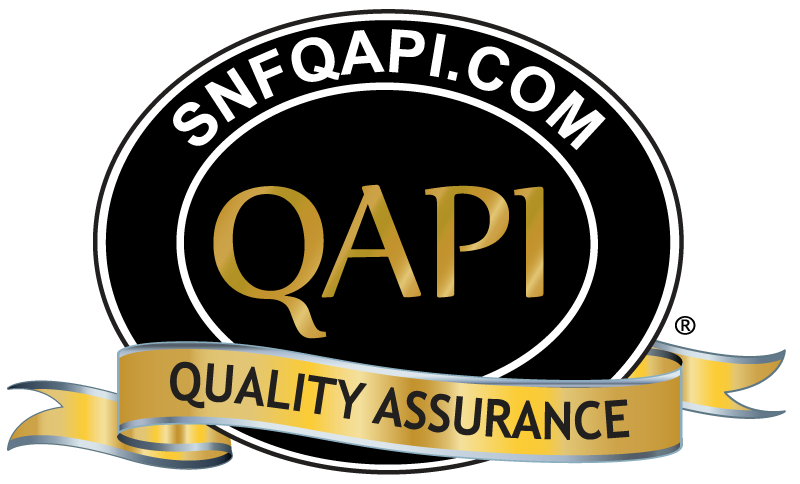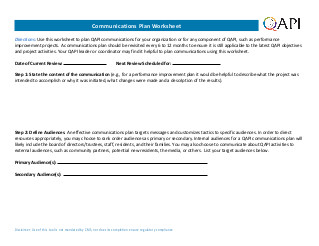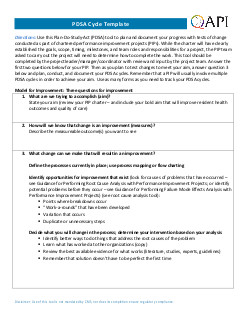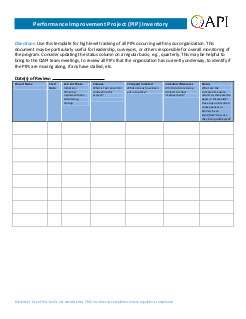12 Action Steps
STEP 10: Plan, Conduct and Document PIPs
Careful planning of PIPs includes identifying areas to work on through your comprehensive data review which are meaningful and important to your residents. It is important to focus your PIPs by defining the scope, so they do not become overwhelming.
You and your team may:
- Consider each PIP a learning process.
- Determine what information you need for the PIP.
- Determine a timeline and communicate it to the Steering Committee.
- Identify and request any needed supplies or equipment.
- Select or create measurement tools as needed
- Prepare and present results.
- Use a problem solving model like PDSA (Plan-Do-Study-Act).
- Report results to the Steering Committee.
PDSA MODEL
PLAN-DO-STUDY-ACT (PDSA) CYCLE
During a PIP you will try out some changes and then see whether or not they made a difference in the area you were trying to improve. In the PLAN stage, the team learns more about the problem, plans for how improvement would be measured, and plans for any changes that might be implemented. In the DO stage, the plan is carried out, including the measures that are selected. In the STUDY phase, the team summarizes what was learned. In the ACT phase, the team and leadership determine what should be done next. The change can be adapted (and re-studied), adopted (perhaps expanded to other areas), or abandoned. That decision determines the next steps in the cycle.
https://www.cms.gov/medicare/provider-enrollment-and-certification/qapi/downloads/qapiataglance.pdf
Communications Plan Worksheet

Directions: Directions: Use this worksheet to plan QAPI communications for your organization or for any component of QAPI, such as performance improvement projects. A communications plan should be revisited every 6 to 12 months to ensure it is still applicable to the latest QAPI objectives and project activities. Your QAPI leader or coordinator may find it helpful to plan communications using this worksheet.
Date of Current Review:____________________ Next Review Scheduled for:____________________
Step 1: State the content of the communication(e.g., for a performance improvement plan it would be helpful to describe what the project was intended to accomplish or why it was initiated, what changes were made and a description of the results).
Step 2: Define Audiences. An effective communications plan targets messages and customizes tactics to specific audiences. In order to direct resources appropriately, you may choose to rank order audiences as primary or secondary. Internal audiences for a QAPI communications plan will likely include the board of directors/trustees, staff, residents, and their families. You may also choose to communicate about QAPI activities to external audiences, such as community partners, potential new residents, the media, or others. List your target audiences below.
Primary Audience(s):__________________________________________________________________
Secondary Audience(s):________________________________________________________________
Step 3: Identify Communications Channels. Consider the different communications channels available for use. Mark any potential channels you may want to use based on whether (a) your organization has had previous success with it or has the resources available to try it for the first time; (b) your staff has the adequate skills and time to appropriately execute it; and (c) funds and other resources are available to support its use.
|
In-Person Channels:
|
Print Channels:
|
|
Media Channels:
|
Electronic Channels:
|
Step 4: Define Approach. Using the table found on the following page, define key aspects of the communications plan based on audience and timeframe.
Each table has room to define a plan for two audiences.
| [Insert Name of Audience] | [Insert Name of Audience] | |
|---|---|---|
| Purpose Why is it important to communicate to this audience? What is the goal of your communications? Do you have a specific need or request (i.e., do you need approval, buy-in, involvement, support)? |
||
| Values What does this audience most value when it comes to this topic? How will the content support these values? How will you express this in your messaging? |
||
| Concerns What is this audience’s greatest concern when it comes to this topic? How can the content alleviate these concerns or overcome them as barriers? How will you express this in your messaging? |
||
| Message What is the key message you want to deliver to this audience at this time? Remember to tie in the audience’s values and concerns. Also address the following: what successes are there at this point? What challenges need to be overcome? What is happening next? |
||
| Channels Which communication channels will you use for this audience (Step 4)? How frequently will they be used? |
||
| Messenger Who will deliver the message to this audience? You may assign the responsibility for delivering the message through each channel to different individuals. |
||
| Evaluation How will you know you were successful? What output will you track (e.g., number of e-newsletters delivered and opened)? How will you monitor the effectiveness of the messages and channels used (e.g., surveys, key informant interviews, observations of changed behavior)? |
PDSA Cycle Template

Directions: Use this worksheet to plan QAPI communications for your organization or for any component of QAPI, such as performance improvement projects. A communications plan should be revisited every 6 to 12 months to ensure it is still applicable to the latest QAPI objectives and project activities. Your QAPI leader or coordinator may find it helpful to plan communications using this worksheet.
Model for Improvement: Three questions for improvement
|
1. What are we trying to accomplish (aim)? State your aim (review your PIP charter – and include your bold aim that will improve resident health outcomes and quality of care) |
|
2. How will we know that change is an improvement (measures)? Describe the measureable outcome(s) you want to see |
|
3. What change can we make that will result in an improvement? Define the processes currently in place; use process mapping or flow charting Identify opportunities for improvement that exist (look for causes of problems that have occurred – see Guidance for Performing Root Cause Analysis with Performance Improvement Projects; or identify potential problems before they occur – see Guidance for Performing Failure Mode Effects Analysis with Performance Improvement Projects) (see root cause analysis tool):
Decide what you will change in the process; determine your intervention based on your analysis
|
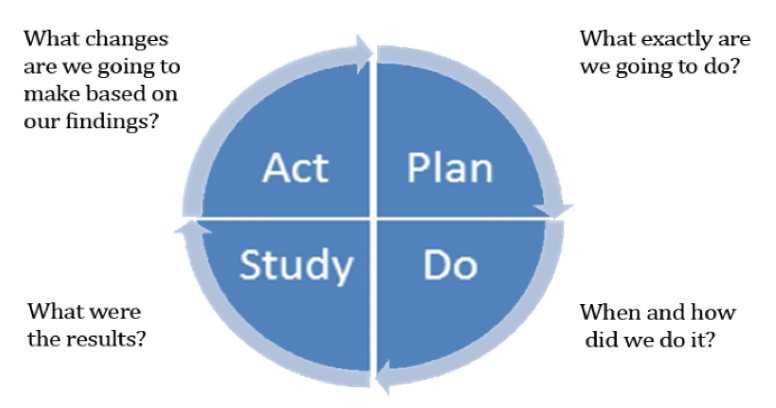
|
Plan What change are you testing with the PDSA cycle(s)? What do you predict will happen and why? Who will be involved in this PDSA? (e.g., one staff member or resident, one shift?). Whenever feasible, it will be helpful to involve direct care staff. Plan a small test of change. How long will the change take to implement? What resources will they need? What data need to be collected? |
List your action steps along with person(s) responsible and time line. |
|
Do Carry out the test on a small scale. Document observations, including any problems and unexpected findings. Collect data you identified as needed during the “plan” stage. |
Describe what actually happened when you ran the test. |
|
Study Study and analyze the data. Determine if the change resulted in the expected outcome. Were there implementation lessons? Summarize what was learned. Look for: unintended consequences, surprises, successes, failures. |
Describe the measured results and how they compared to the predictions. |
|
Act Based on what was learned from the test: Adapt – modify the changes and repeat PDSA cycle. Adopt – consider expanding the changes in your organization to additional residents, staff, and units. Abandon – change your approach and repeat PDSA cycle. |
Describe what modifications to the plan will be made for the next cycle from what you learned. |
Performance Improvement Project (PIP) Inventory

Directions: Use this template for high level tracking of all PIPs occurring within your organization. This document may be particularly useful for leadership, surveyors, or others responsible for overall monitoring of the program. Consider updating the status column on a regular basis; e.g., quarterly. This may be helpful to bring to the QAPI team meetings, to review all PIPs that the organization has currently underway, to identify if the PIPs are moving along, if any have stalled, etc.
Date(s) of Review: ________________________
Project Name |
Start Date |
Current Phase Initiation, Planning. Implementation, Monitoring, Closing |
Purpose What is the reason for conducting this project? |
Change(s) Initiated What actions have been put into place? |
Indicators/Measures Which data are being tracked to show improvement? |
Status What are the indicator/measure results as compared to goals or thresholds? Have any unintended consequences or barriers been identified? How are they being addressed? |
|---|---|---|---|---|---|---|
